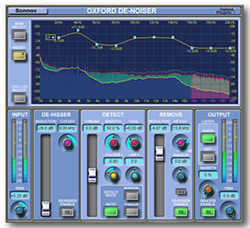SONNOX (Oxford) Denoiser Native
Hersteller: SONNOX (Oxford)
Weitere Informationen:
http://www.sonnoxplugins.com/pub/plugins/products/Restore-DeNoiser_Info.htm
245,00 CHF
Produktbeschreibung
The Oxford DeNoiser removes wide-band noise from audio material using a variety of sophisticated techniques. The key to good de-noising lies in helping the user produce pleasing and accurate results, rather than encouraging the over-aggressive use of controls.
The Oxford DeNoiser is based around the concept of a ’noise profile’. The noise profile is used to gate-out components of the frequency spectrum that are below it, and keep the components that are above it. There are several methods to arrive at an appropriate noise floor.
Three Detect Modes
AUTO: In Auto mode the frequency spectrum of the signal is examined to automatically acquire the general shape of the noise threshold profile by looking for levels in the frequency spectrum that are consistently there. In this mode, the threshold is relative to the general signal level and therefore noise removal will always be a fixed number of dBs below the actual signal.
FREEZE: Another method to arrive at an appropriate noise profile is to use the Freeze button to freeze the automatic noise profile, and use that fixed profile from then on. This is useful for capturing the profile from a section of material containing only background noise, and then applying it to the rest of the material. The advantage of Freeze mode is that the threshold is always set to remove the correct level of noise from the material, meaning that as the level of the programme material climbs, the noise removal is less destructive.
MANUAL: In this mode you manually specify a simple coloured noise profile, using the Colour and Air controls. Colour adjusts the shape of the noise-profile from white to red noise, Air modifies the HF shape of the noise-profile.
In most cases, Auto mode gives the most sympathetic results, as the level of the threshold will follow the level of the actual signal.
Fine Tune
For additional control, the DeNoiser has the ability to adjust the theshold of the noise-profile at different frequencies by means of a bias curve. There is also a bias curve to adjust the amount of reduction at various frequencies allowing more noise removal at some frequencies while still being gentle at other frequencies. These bias curves work in all three modes - Auto, Freeze or Manual. Further manipulation of the detect threshold and reduction amount is available in the form of the Smooth and Tune controls.
DeHisser Section
The Oxford DeNoiser also contains a dedicated DeHisser section before the broadband noise-removal section. This can be used quite aggressively on audio such as dialogue where there is not a lot of high frequency content that needs preserving, and where the priority is to reduce the hiss to an acceptably clean level.
Mid/Side Mode
There is a Mid/Side operation mode in the DeNoiser, which causes the plugin to de-noise only the Side signal content of the Left-Right signal, leaving the Mid content alone. The Left-Right signal is first converted to Mid-Side, then the Side is de-noised, then the signal is converted back to Left-Right. This is of course particularly useful in broadcast where switching between stereo and mono should not cause a noticeable change in dominant noise content.
DeNoising only the Side channel means that mono operation is entirely unaffected while stereo operation produces a cleaner stereo image without affecting the central sound. Secondly, recordings made with the Mid-Side microphone technique often have more noticeable noise in the Side signal because the Side signal is mainly ambiance. If the Mid-Side recording is then converted to Left /Right at some point,the Mid-Side mode of the DeNoiser allows you to de-noise just the Side content.
Sweetening
Having removed the noise, in some circumstances it is desirable to add something back to the signal that has been taken away. For example, the act of de-noising can make the material sound a little flat compared with the original. The Oxford DeNoiser has a ’Warmth’ control in the output section that can quickly add some richness back into the material.
As with all three plug-ins in the Sonnox Restore suite, there is the option to listen to the ’Diff’ signal, which is the difference between the input and the processed output. This is useful for listening to the noise that is being removed, to ensure that ’good’ audio is not removed from the output signal.
UP BEAT verkauft auch alle aktuellen SONNOX Specials + Aktionen, falls hier nicht aufgeführt oder aktualisiert, bitte anfragen !
Wir erhalten direkt von SONNOX die Serial Number.
Weitere Informationen: http://www.sonnoxplugins.com/pub/plugins/products/Restore-DeNoiser_Info.htm
Bewertungen

